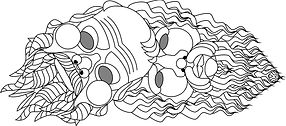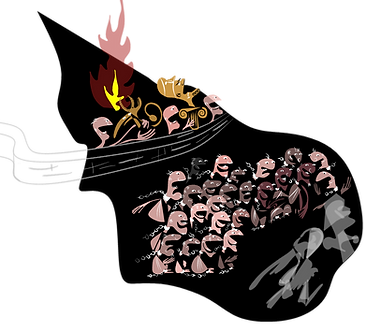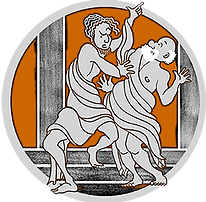[Or go right to the latest OBZ page]

Reason & Persuasion
Three Dialogues by Plato: Euthyphro, Meno,
Republic Book I
written and illustrated by John Holbo; translations by Belle Waring
Buy from AMAZON
"There is no dearth of textbooks offering an introduction to Plato's thought, but Holbo's stands apart in the scope of its introductory material and its user-friendly style. The book is divided into two parts. The first part, taking up a full quarter of the volume, introduces Socrates, Plato and the whole issue of how to read a Socratic dialogue. The second part is comprised of the three dialogues - Euthyphro, Meno and Republic I - each with its own forty or so page commentary. Thus more than half of the book is aimed at making the dialogues accessible to students who are without any prior experience reading Plato in particular or philosophy in general. The colloquial yet accurate translation by Belle Waring serves to reduce the distance between the student and the world of the dialogues still further and the illustrations found throughout punctuate the text with what Holbo calls bullet points without words."
- Notre Dame Philosophical Reviews


Too much to digest?
Download individual chapters below!
A short chapter, introducing Plato and Socrates. The subtitle indicates that one thing that makes reading this stuff tricky is knowing who we're dealing with. Plato is sneaky. And Socrates was no slouch in the not-being-straightforward department either.
Another short chapter: Socrates for beginners. Basic background and preliminary considerations about Socratic method. Why focus on definitions? Why so negative: always asking, never answering? Why bother people like that?
Plato introduced via discussion of his most famous Myth: the Cave. Brief explication and defense of Plato's Theory of the Forms. Should you buy it? Probably not the package. Maybe a portion? It's in the metaphysical background of Plato's thinking. Plausibly, a lot of dialogues, including our three, are hinting at this picture. So it's good to know what it is/
All of Western philosophy is footnotes to Plato; Socrates, its first saint and martyr. Still, there's something off-putting about this attractive pair. And about these dialogues. A lot of Socrates' interlocutors (debating partners) are incompetent. Why? To answer, I consider Plato's love-hate relationship with rhetoric. What's he doing, and not, to win friends and influence people? 'Argument' has two senses. It means: justificatory structure. Propositions intended to establish the truth of propositions. A proof is an argument. 'Argument' also means: verbal fight. Two monkeys yelling at each other. Plato is giving us both at once, by writing dialogues: abstract proofs. And some monkey-business. What happens when logic (the way you should think) meets psychologic (the way people actually think)? Think of the dialogues as a stress-test, in this regard.
This is a long chapter of commentary on Plato's Euthyphro. It covers the basics: Euthyphro's case. His failed attempts to give an account of holiness. The chicken-and-egg quality of 'is it good because the gods love it, or do they love it because it's good?' Quite a bit of discussion of ancient Greek religion and law.
The full text of Plato's dialogue, Euthyphro. Euthyphro, a priest (technically, a mantis - no, not a bug) is prosecuting his father for murder. Is it pious - holy? - for a son to do so? Well, what is holiness? It's a short dialogue, and relatively straightforward, hence a common starting point for Philosophy 101 students.
This chapter bookends Chapter 4, rounding out themes, completing a few thoughts. The dialogue, Meno, has an odd virtue-geometry-virtue structure, which tends to throw readers (it throws Meno.) Most basic elements of this dialogue - including the virtue+geometry mix - have intuitive analogs to issues, ideas, personality-types, typical responses that we recognize today. But such analogies are not always immediately obvious. Meno is an example. A very normal guy. You know this guy. But today that guy wouldn't ask 'what is virtue?' He would attend self-help seminars about what it takes to be a success, to get ahead in life. This self-help angle means the dialogue is at odd angles to moral theory, as it tends to get taught in Philosophy 101 these days. But part of Plato's point is that Meno ought to think more like philosophers do today - more theoretically, that is. It's too simple to say Plato thinks ethics should turn into geometry. But geometry is an important, aspirational paradigm for Plato. Last but not least, I discuss so-called positive psychology and Jonathan Haidt. The point is 1) to make Plato intuitive, by relating him to intuitive things; 2) to spar with Haidt, a bit, on Plato's behalf.
The full text of Plato's dialogue, Meno. Meno, sophist-in-training, wants to know what Socrates thinks virtue is. Soon Socrates has Meno sorting virtue from non-virtue, getting him all out of sorts. (This feels like it should be easy, saying what virtue is! There's all sorts of virtues, after all.) There's a geometry lesson in the middle, but the point isn't to solve the problem (constructing a square of the right area); rather, to solve the problem of how the mind solves such problems. How do we learn and know things? Socrates advocates a doctrine of innate ideas. We also meet Anytus, sturdy Athenian citizen. One thing that makes the dialogue hard to follow is that Plato (Socrates, if you prefer) is targeting the low common denominator of Meno and Anytus. But they don't look alike: this slick sophist, this stiff, anti-sophist. so what thing do they both get wrong? Answer: they think they know it all; and nothing can be known. A contradiction, and a form of double-insulation against Plato/Socrates' message: maybe you could know better?
A long chapter of commentary on Plato's Republic, intended to serve as an introduction to/commentary on Book I (so mostly the chapter talks about Book I.) Book I is a stand-alone production. But also the gateway to the larger literary/intellectual structure beyond (Republic is 10 books long.) What is Plato's account of justice, in Republic? Justice is harmony, in the City as in the Soul. But that comes later. In Book I, three interlocutors have a crack at it. The man - Cephalus - and son - Polemarchus. Those two typically get short-shrift compared to Thrasymachus, whose provocative, egoistic immoralism - "Justice is the advantage of the stronger" - occasions the rest of the discussion in Republic. Can Socrates refute this? Yes he can! Thrasymachus doesn't have a theory so much as a set of proto-theoretic moves that seem plausible, mutually fitting. Socrates finds points of weakness and slippage, of course. Then we do it again, much more elaborately, in Books 2-9 (Book 10 is something else. Some of that material is discussed at the tail end of Chapter 7, if you are curious.)
The full text of the first book (it's like a chapter) of Plato's Republic. What is justice? Socrates refutes three accounts by three interlocutors. The old man, Cephalus: justice is speaking truth and paying your debts. His son, Polemarchus: justice is helping friends and hurting enemies. Thrasymachus: justice is the advantage of the stronger. Often Socratic interlocutors are not very good at this definitions game. They don't think ahead. They don't see how offering a general account means implying many things, means opening yourself up to counter-examples and objections - so you'd better be ready to shift your stance, make adjustments, anticipate. Thrasymachus is a bit better at that than anyone else we meet: Euthyphro, Meno, Cephalus, Polemarchus. But he gets refuted in the end, like everybody else.









